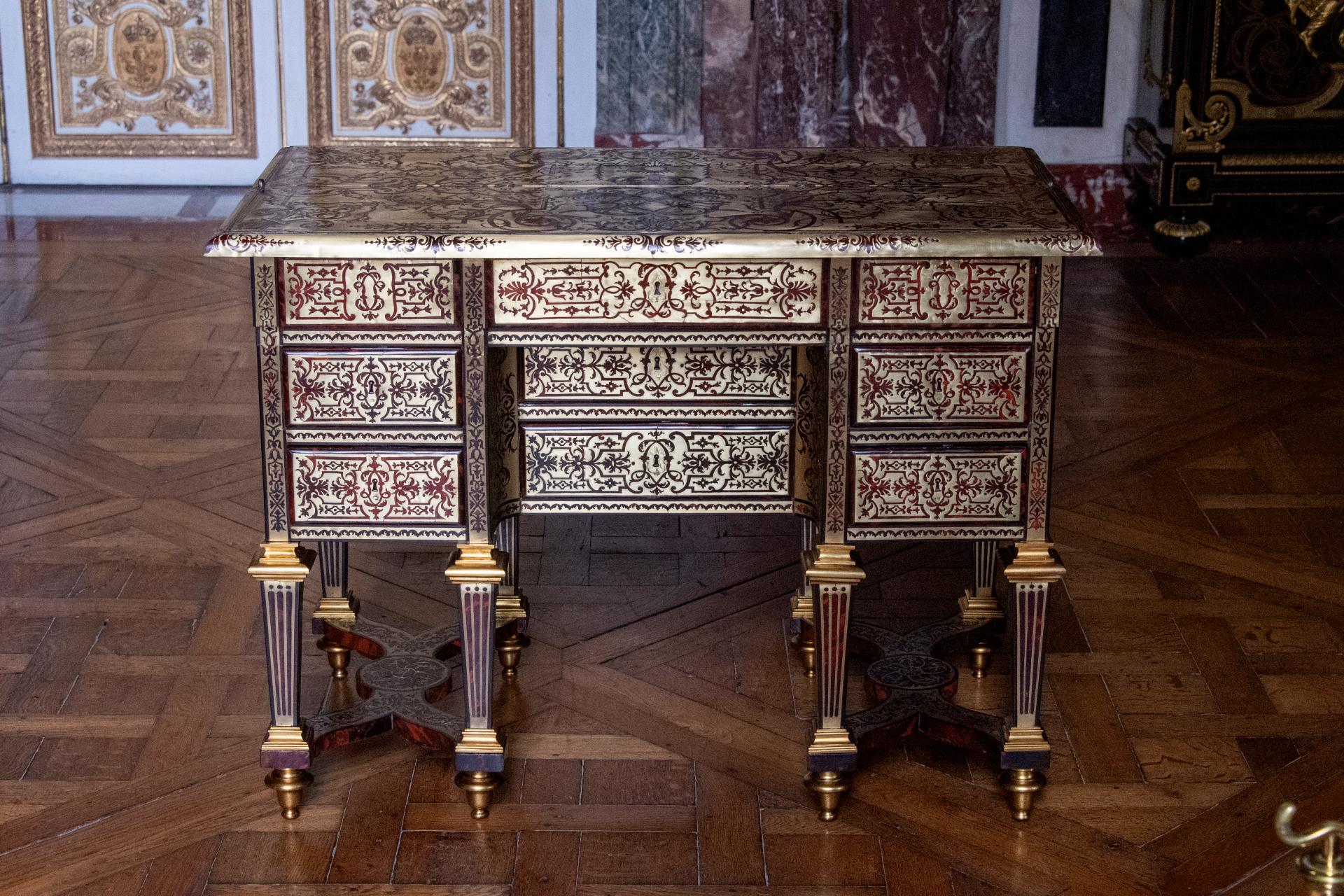In 2015, thanks to the patronage of both Axa and the Society of Friends of Versailles, the Palace of Versailles was able to acquire one of two folding-top desks that once belonged to Louis XIV. Now fully restored, it is on display in the Room of Abundance and can be viewed as part of the tour of the State Apartments.
Return of Louis XIV’s desk
The king’s desk
One of a pair of folding-top desks (before restoration) delivered in 1685 for the king’s private chamber at Versailles. © Château de Versailles, Dist. RMN / © Christophe Fouin
During the makeover of the King's apartment, in 1684, certain important commissions were given to the cabinet-maker Alexandre-Jean Oppenordt.
He worked closely with Jean Bérain, designer of the king’s bedchamber, to create a pair of "bureaux brisés" (or folding-top desks), inlaid with tortoiseshell and brass for the “King’s private writing chamber” – a room behind the sovereign’s apartment to which he could retreat. The commission was delivered in spring 1685.
This type of desk, known in French as “brisé” (broken), was considered less practical than so-called "flat" desk. The two desks were later placed in the furniture store-house at the Palace before eventually being sold, on 1 July 1751.
ACQUISITION
In November 2015, thanks to the patronage of Axa and the Society of Friends of Versailles, the Palace of Versailles made the special acquisition of one of the desks, which had been converted into a tiered sloping desk in the late 19th century. After more than 260 years and an intensive restoration effort, it has returned to its “forever home”.
As for the second desk, it is held in the collections of New York’s Metropolitan Museum of Art (the MET), which acquired it at the end of the 20th century.
Restoration
As it was in need of restoration, the desk acquired by the Palace of Versailles was entrusted to the Centre for Research and Restoration in French Museums (C2RMF). The experts there conducted various studies (X-rays, wood dating, composition of the varnishes, etc.) to get to “the heart of the unit” and reveal the damage caused by the marquetry lifting and makeshift repairs.
They then had to decide whether to carry out a conservation restoration, meaning the unit would be preserved in the form in which it was acquired (as a folding-top desk), or restore it to its original 1685 condition (as a flat-top desk). The scientific committee decided to restore it to its flat-top form, which meant having to determine precisely which elements had been lost during the conversion.
Practically speaking, restoring the desk required having to break it down into sub-assemblies and then into individual pieces. Converting it then involved making the sloping flap – which had initially been used as the desk’s surface flat. The surface was also converted to open into two parts, as it had originally. The varnishes, which were very thick and old, were replaced to restore the colour, patterns and tones of the tortoiseshell.
presentation
Following its restoration, the king’s desk is now on display in the Room of Abundance and can be viewed as part of the tour of the King’s State Apartment.
The king’s desk in the Room of Abundance, November 2022 © EPV / Didier Saulnier
Modelling
Explore this 3D model of the folding-top desk, which was converted into a tiered sloping desk in the late 19th century and then restored to its original, late 17th-century condition.
Folding-top desk (or bureau "brisé") : before and after its restoration
Opening system of the folding-top desk and its drawers (17th-century model)
Exploded diagram of the folding-top desk (19th-century model)
This 3D model was created with the “digital reconstruction” technique used by Philippe Dechenaux, of ExploVision. In a process of reverse engineering, the elements of the unit are modelled individually using CAD software before the entire desk is reconstructed, strictly in accordance with the dimensions noted.
Following its restoration, the desk has been returned to the Palace of Versailles Collections and is now on display in the Room of Abundance, conjuring up Versailles as it was during the reign of Louis XIV.




